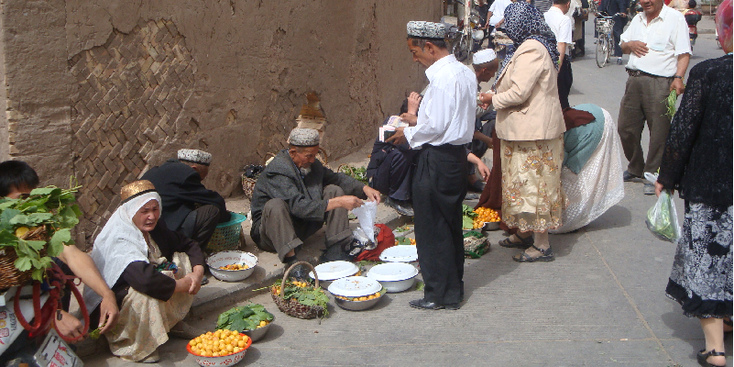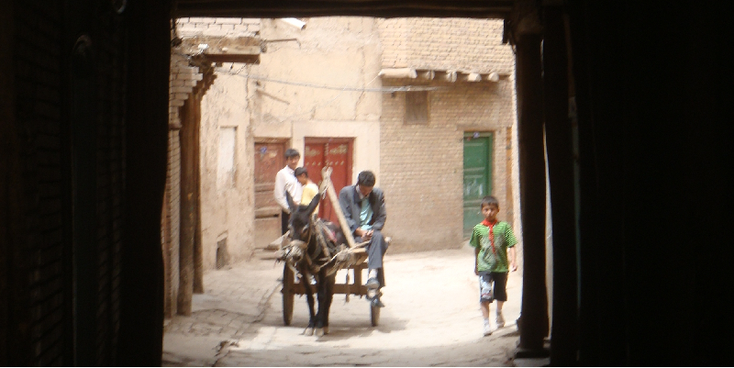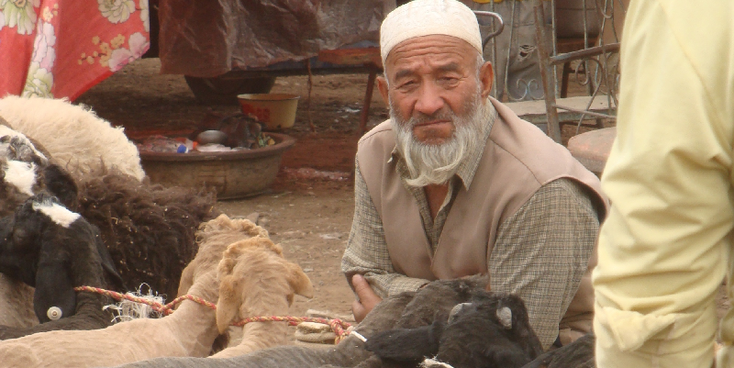Kashgar
Places of Interest - China


introduction
The old oasis town of Kashgar lies to the west of the Taklamakan desert, in the far west of China. It lies at 1304 m altitude at the foot of the Pamir Mountains and at the Qashqar darya. The population consists predominantly of Uyghurs and with that the city is predominantly Muslim.
The cityscape is dominated by Islamic architecture including the bazaar and the large Id-Kah mosque. The Chinese government is carrying out a major modernization of the city. The old city is systematically demolished and modernized. The Go West policy of the Chinese government, in which Han-Chinese are encouraged to move to the western Chinese provinces through subsidies and tax credits, leads to an increase in the percentage of Han Chinese which results in a rapid change of the city.
Kashgar is a starting point (or destination) of the Karakoram road that connects China with Pakistan and the Torugart pass, which connects China with Kyrgyzstan and is traditionally important as a trading center (junction of caravan routes). The industry is mainly based on agriculture (production of leather, silk, cotton and foodstuffs), construction of agricultural machinery) and furthermore the cement industry and the traditional manufacture of carpets.
highlights

Sunday market:
Once a week, on Sundays, it seems like the whole region is coming to Kashgar to sell and buy stuff. A gigantic market where you can buy and sell everything. Carpets, clothing, shoes, hats, old Ugur knives and also many souvenirs nowadays. The best experience you can have is to eat in a local joint between local market people, but you have to look out for your wallet.
With a local bus (number 16) you can go a little further than the actual city (and market) to the animal market. Thousands of sheep, camels, horses, cows, goats and I know a lot more is being traded on a encircled site. You have to have a bit of good intestines to walk around here – sometimes they don’t treat the animals like we want to see it. You have to think that it has been the same way here for centuries.
The market is getting more popular every year but I hope i twill keep it’s local sense and atmosphere and it doesn’t turn out to be a tourist-market in the future.

The old (inner) city:
You are probably too late to see the old city in its glory. The Chinese have decided to destroy the whole old "mud" city and put down new buildings in a touristy way. A thorn in the eye of every (Western) tourist what an average Chinese does not seem to understand.
Small, narrow streets and alleys where children kick a ball and girls jump rope. Stroll through it, get lost and you might be lucky that someone invites you to one of the courtyards behind the high walls where the old Ugur people live and work.
Other attractions:
- A visit tot he Id Kah mosque.

history

Kashqar was originally a city state in Sinkiang, which was repeatedly subjected to Huns and Han Chinese until the 8th century. In 78 AD. a Chinese garrison was stationed there. The city came into the hands of the T'ang dynasty at the end of the 7th century and then successively in the hands of Turkish Karluks (8th century), Uyghurs (10th-11th century) and Kara-kitai (12th century).
The city is traditionally important as a trading center (junction of caravan routes) and is the westernmost Chinese Silk Road city. With the conquest by the Mongols in 1219 began a flourishing period, which ended with the looting by Timoer Lenk (14th century). At the time of the Tj'ing dynasty, the city became Chinese again (1755). Since 1755, the city has repeatedly been the scene of Islamic uprisings (especially 1862-1875 and 1928-1937). In the 19th century, a Central Asian warlord, Yakub Beg, proclaimed khan of the state of Kashgaria. After his death in 1877 the area came under Chinese rule again.
In early August 2008 Kashgar was the scene of an attack against the Chinese border police. Sixteen agents were killed and sixteen more were injured according to the Chinese state news agency Xinhua. Two people entered the border post in Kashgar with a van and threw two bombs that exploded immediately. According to the Chinese police the attack had a terrorist character and he could be linked to a militant separatist group, the Islamic Party of Turkestan. In February 2009 the Chinese government started moving 50,000 families from the old center of Kashgar.
The demolition of the more than 1000 years old city center, where Uyghurs in particular live, is a thorn in the eyes of architects and archaeologists, who regard the local architecture as unique. The reason for the demolition is given by the Chinese government that the old city would be eroded and outdated by its age and that the old houses would be at risk of collapse during an earthquake. The demolition would also be necessary to install sewers, water pipes and wider streets. Kashgar is one of the last cities in Xinjiang where traditional Uyghur architecture and culture can still be found.
Most Uighur homes in other cities have already made way for Chinese flats and highways in recent decades.

tips & advice (2009)

You can walk (or with a local bus) to the international bus station outside the old city - it is about 1 to 2 km on the north side.
Kashgar - Osh (KIRGISTAN): a bus (475 RmB) drives to the second city of Kirgistan on Monday morning at 8:00 am. The ride lasts for 28 hours.
TIPS:
-
Take a good look at what time you use when you book a bus ticket - what time do they use? Beijing time or Xianjiang time?
-
Everyone wants (being a tourist) to cross the Torogart Pass - when I was there, no bus was going over the pass. Beware of money beating (even if you want to go with a truck) and whether it is possible in terms of weather (snow).

Especially in the old town you can score a delicious "shaslick" outside on an outside local grill. In addition, you can eat "laghman" almost everywhere (try a local eatery). For a beautiful panorama you can go to the local tea house (in the old town street where the hostel is located) - this is located on the 1st floor (chai hanna) and you have a good view of the vendors and life below you.

-
Name: Hotel Old City Hostel
Address: NO.233 in Wusitangboyi road
Price: 35 Yuan (dormitory)
Phone nr. : Tel: + 86-998-2823262
Website: http://www.kashgaroldcity.hostel.com/
Content:
In the center of the old city, this hostel is hidden away but wort hit - you have to look really well. It has a large courtyard where often motorcycles of tourists are parked and/or a jeep. Around this courtyard are a kind of high wooden plateaus with cushions and low wooden tables. This is the meeting place although there is also a kitchen where you can sit.
There are different types of rooms (including a single) but also large dorms (4, 6 or 8 person). The showers and toilet are outside and breakfast is exclusive. Especially the atmosphere here is fantastic.

see also:
LANDEN:
EUROPA:
Albanië * België * Bosnië-Herzegovina * Bulgarije * Denemarken * Duitsland * Engeland * Estland * Finland * Frankrijk * Griekenland * Hongarije * (Noord) Ierland * Italië * Kosovo * Kroatië * Letland * Litouwen * Luxemburg * Macedonië * Malta * Montenegro * NEDERLAND * Oekraïne * Oostenrijk * Polen * Portugal * Roemenië * Rusland * Schotland * Servië * Slovenië * Slowakije * Spanje * Tsjechië * Turkije * Zweden
NOORD EN CENTRAAL-AMERIKA:
Chili * Costa Rica * Cuba * Guatemala * Mexico * Nicaragua * Panama * Verenigde Staten
ZUID-AMERIKA:
Argentinië * Bolivia * Brazilië * Colombia * Ecuador * Peru
AFRIKA:
Botswana * Burkina Faso * Egypte * Ethiopië * Ghana * Kenia * Mali * Marokko * Namibië * Oeganda * Senegal * Tanzania * Tunesië * Zuid-Afrika
MIDDEN-OOSTEN:
Iran * Israël * Jordanië * V.A.E.
AZIE:
Armenië * Cambodja * China * Filipijnen * Georgië * India * Indonesië * Japan * Kirgizië * Laos * Maleisië * Mongolië * Myanmar * Nepal * Oezbekistan * Singapore * Sri Lanka * Thailand * Vietnam
OCEANIE:
Voor meer reisfoto's kijk op www.instagram.com/cheapskatetravel.nl:
© Cheapskatetravel.nl; 2018 (all rights reserved)


